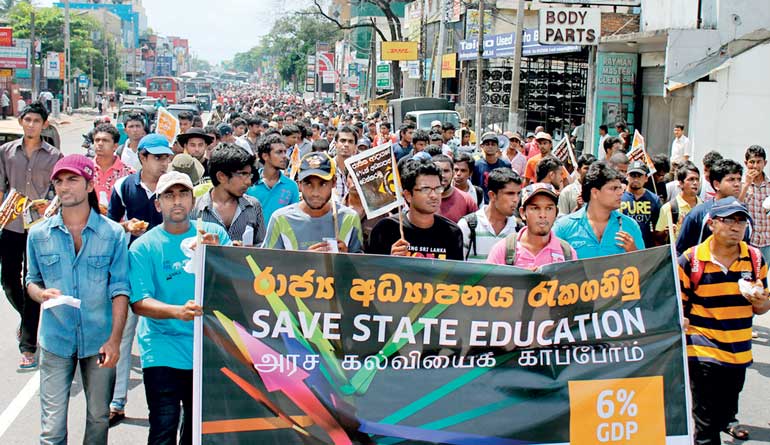Friday Oct 17, 2025
Friday Oct 17, 2025
Wednesday, 14 October 2015 00:00 - - {{hitsCtrl.values.hits}}

Pressurising the Government to increase its investments in the higher education sector has become the breeding ground for a number of protests in recent years
By Dinesha Samaranayake
As a happy graduate of a private university, I’ve always wondered how my life would’ve been if my parents could not afford to pay for my education.
Those of us who didn’t get “good” marks to be accepted to a State university were usually looked down upon. I suspect many with similar experiences will remember how difficult it was to tell your results to those judgemental people and the sinking feeling in your gut when you hear the question “What are you going to do next?” 
Private universities were the last ray of hope for those of us who got left behind from the rat race. Unfortunately in Sri Lanka being able to afford private university education is considered to be a luxury and is limited only to handful while the majority is excluded from this basic human right.
Human capital plays a crucial part in absorbing innovation and executing highly value-added transactions throughout the process of development. However, given the limited capacity in Sri Lanka’s higher education system, many able and deserving individuals are restrained from achieving their true potential.
It is no secret that the GCE Advanced Level examinations conducted in Sri Lanka, which serves as the entrance level examinations to enrol at State universities, is one of the most competitive and highly-advanced examinations that a student will ever face. However, not all who pass are fortunate enough to get into a State university.
Based on the statistics from the Sri Lanka National Human Development Report 2014 on Youth and Development: Towards a More Inclusive Future (NHDR), for the academic year 2010/2011, only 15.2% of youth respondents were admitted to local universities out of all qualified students. This means the remaining 84.8% of respondents who proved to be eligible for higher education have had to fend for themselves. In this context those who possess financial means might opt for private universities in Sri Lanka or overseas while the rest are usually absorbed into the unemployed, underprivileged population.
Pressurising the Government to increase its investments in the higher education sector has become the breeding ground for a number of protests in recent years. However, Government reactions have been moving at snail’s pace. Data published by the University Grant Commission indicates that even though state investments in higher education increased in absolute terms from 2010-2012, if taken as a percentage of the GDP of the respective year, the investment has, in fact, decreased.
Excessive layers of Government departments with age old rules and procedures mean that even if the Government increases its investment in education, the effects will not be immediate. Hence, we must look at other ways to tackle this resource gap.
In my opinion, one of the fastest and most effective ways to address this need is through “privatisation”. Yes, I do agree that privatisation does have negative outcomes, and for many critics of privatisation this could be the ultimate bitter pill. Yet, I choose to be optimistic.
If managed carefully, privatisation could be the best solution available to meet the demand for higher education. However, it is important to strategise carefully before taking up this path.
Currently, some of the private higher education institutions that award degrees in Sri Lanka are in fact registered as private companies and the University Grants Commission (UGC) has no clear understanding of the standards of the degrees they offer. If the government could identify clear-cut educational areas that could be expanded to achieve the required GDP target, then the UGC could open the higher education market to entities from the private sector that are strong in these respective areas.
One of my favourite examples is the educational reforms undertaken in India. India’s Ministry of Human Resources Development (MHRD), which oversees all plans and policies for education, publicly placed considerable emphasis on ICT (Information and Communications Technology) education. Due to this reform, there is now an abundant work force that is tech-savvy. This has proved to have given India a distinct comparative advantage as ICT activities of many multinational corporations are now outsourced to India, leading to India being recognised as a key outsourcing hub globally.
If we follow a similar thinking pattern we could identify sectors that will be in demand in the future and prioritise educational reforms in these areas. For example, tourism has been given much emphasis in the plans for economic development in Sri Lanka. Coincidentally, a global tourism trend that is gaining traction is health tourism. If we increase the supply of fully qualified medical professionals, this is just one promising market that we can capture in the future.
Sadly, any plans to establish private medical schools have been badly criticised by both the public and medical professionals. This may be due to a lack of proper understanding by the public, but for such medical professionals, perhaps it is a mix of losing the monopoly power and benefits that are bestowed on them by the current system.
Another criticism of privatisation is that these institutions will operate with the sole objective of profit maximisation which could threaten the quality of the education and the opportunity for equal access. Yes, these are fair concerns but can be managed if regulated properly by the UGC. Well reputed universities in the world use a quota system where highly deserving underprivileged students have access to universities through a fully paid scholarship programs.
These universities often strive to attract the best students to their programs as this is the best indication of the standard of their programs. A similar method could be introduced in private institutions in Sri Lanka under the guidance of the UGC. If the market for higher education opens up, there will be more competition in the market leading to current big players reducing their prices in order to stay attractive. This means more students will be able to afford higher education rather than an affluent few as in the case of the current situation.
It is important not to look at private universities as the enemy of government-funded universities, but as an effective means of absorbing the remaining 84.8% of the qualified student population, ultimately benefiting Sri Lanka’s labour force.
While the Government can gradually increase the capacity of local universities, private universities will be able to respond to immediate demands in the country. Having said that, I also believe that privatising highly regulated sectors such as medical schools is easier said than done. We only need one minister who has his or her heart in the right place to withstand criticisms and take up the challenge.
(UNLOCKED is a space for Sri Lankan youth to express their views and opinions on development with the aim of creating positive change in the world. The views expressed in the blogs are solely those of the authors. UNDP Sri Lanka and Daily FT does not represent or endorse the views expressed in these blogs. Read more about the UNLOCKED initiative www.lk.undp.org.)